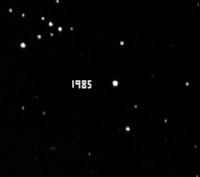Stellar kinematics

Let's imagine you're playing with a bunch of marbles, and you want to observe the way they move around on a flat surface. You can use markers to draw a map with some labeled start and finish points to track the movement of the marbles.
Now let's imagine that instead of marbles, you're tracking the movement of stars in our galaxy, the Milky Way. Instead of markers, scientists use telescopes to look at the stars and measure their movements in different directions. They do this by observing how the light from the stars shifts from blue to red or vice versa, based on whether the star is moving toward or away from us. This shift in light is called the Doppler effect.
Scientists use this information to study stellar kinematics, which is basically the study of how stars move around in the galaxy. They can observe how individual stars move in different directions and at different speeds, and they can also look at larger groups of stars to see how they move together in clusters or spiral arms.
By studying the movement of stars, scientists can learn more about the structure and history of our galaxy. They can determine the shape of the galaxy and identify areas where new stars are forming. They can also use this data to help explain phenomena like black holes and dark matter, which are still not completely understood.
So, stellar kinematics is like tracking the movement of marbles on a flat surface, but instead of marbles, scientists track the movement of stars in the Milky Way using telescopes and the Doppler effect. This helps them learn more about the structure and history of our galaxy, and explain mysterious things like black holes.
Now let's imagine that instead of marbles, you're tracking the movement of stars in our galaxy, the Milky Way. Instead of markers, scientists use telescopes to look at the stars and measure their movements in different directions. They do this by observing how the light from the stars shifts from blue to red or vice versa, based on whether the star is moving toward or away from us. This shift in light is called the Doppler effect.
Scientists use this information to study stellar kinematics, which is basically the study of how stars move around in the galaxy. They can observe how individual stars move in different directions and at different speeds, and they can also look at larger groups of stars to see how they move together in clusters or spiral arms.
By studying the movement of stars, scientists can learn more about the structure and history of our galaxy. They can determine the shape of the galaxy and identify areas where new stars are forming. They can also use this data to help explain phenomena like black holes and dark matter, which are still not completely understood.
So, stellar kinematics is like tracking the movement of marbles on a flat surface, but instead of marbles, scientists track the movement of stars in the Milky Way using telescopes and the Doppler effect. This helps them learn more about the structure and history of our galaxy, and explain mysterious things like black holes.
Related topics others have asked about:
